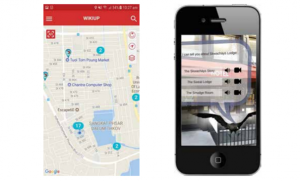Indigenous storytelling simultaneously convey what has happened in the past, what is happening in the present, and what could happen in the future: circularity in time, space and continuity is intrinsic to Indigenous worldviews (Myburgh, 2018). Many of my previous blog posts have illuminated the ingenuity of AR technology storytelling in ways that empower Indigenous creators to connect their cultures, the land and the technology to engage a new generation of users. Wikiup is an AR project that enhances the Canadian landscape with superimposed digital interactions; this facilitates interaction between elder storytellers and users who are dubbed as “story catchers”, enabling the transfer of traditional knowledge about a particular location (Myburgh, 2018). Overlaying digital interactions onto physical places empowers Indigenous creators to “reclaim” their lands and, in a sense, their sense of “sovereignty” as well.

Figure 1. Myburgh (2018). Wikiup, produced by Adrian Duke, AR application screenshots, 2017. Retrieved June 11, 2021, from https://www.proquest.com/scholarly-journals/supporting-self-determined-indigenous-innovations/docview/2035667161/se-2?accountid=14656. Screenshot by Vancouver Native Housing Society.
However, Myburgh (2018) notes the question of access to video and mobile technologies that can host AR art as a challenge for Indigenous communities across Canada. Broader issues of the digital divide should be addressed in conjunction with providing access and resources to AR technology in particular. Myburgh (2018) emphasizes that AR technology presents ample opportunity for Indigenous artists to investigate issues pertaining to culture, memory, and place.
References
Myburgh, B. (2018). Here and Now: Indigenous Canadian Perspectives and New Media in Works by Ruben Komangapik, Kent Monkman and Adrian Duke. Leonardo 51(4), 394-398. https://www.muse.jhu.edu/article/702020
Hi Amy,
I agree that it’s important to consider how familiar Indigenous communities are with these types of technologies. Even if the technology is available, if community members don’t know how to utilize them, it would be pointless. This applies to any technology implementation but it’s especially important for Indigenous communities, as I think AR or VR technologies have the potential to create holistic methods of storytelling.
Amy,
Great find! This paper touches on much of what interests me about AR and its use in place-based storytelling. However, in my research I found that, surprisingly, “Wikiup” no longer exists. Have you found otherwise?
Thanks again for this paper. This will likely show up in my final project references.
Neal